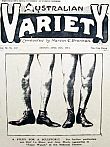Following the disbanding of the American Burlesque Company in early 1914, Bert Le Blanc decided to remain in the country in order to capitalise on the success he had established throughout the previous twelve months. During his first year in Australia, he performed solo engagements in Sydney and Melbourne for the Fullers while also being leased out temporarily to other managements, such as Dix-Baker in Newcastle (ca. 1914). Although popularly received by audiences, the consensus among critics was that he 'would score better in vaudeville if he had a feeder' (Australian Variety 18 November 1914, p.3). The partnership he needed came about through his engagement by George Willoughby for the pantomime Babes in the Wood (Adelphi Theatre, Sydney). The debut 1914 production saw Le Blanc cast as Weary Willie alongside Australian comedian Ted Stanley as Tired Tim. Following its Sydney season, which ended in early February 1915, Babes in the Wood went on a national tour, and Stanley was replaced by American Hebrew comedian Jake Mack (born Jacob Snoek). This partnership was so successful for the pair that they went on to spend the next ten years working off each other in revusicals and in vaudeville.
Although Le Blanc was considered one of the country's foremost comedians, he did not, in fact, take on the role of principal comic in his revusicals, working more often than not as Jake Mack's feed. This was 'a generous arrangement from Mr Le Blanc's point of view', suggested the Theatre Magazine's vaudeville critic, X-Ray, 'for Mr Mack is given every opportunity of scoring with the audience, even at the expense of Mr Le Blanc' (June 1916, p.39). Not all of the dialogue between the two was weighted in favour of Mack, however. As the following gag demonstrates, Le Blanc's sense of larrikin humour undoubtedly struck a chord with Australian popular culture audiences, even though he was playing a Hebrew. In the skit, Le Blanc, a diner in a restaurant questions the waiter (Mack): 'What do you charge for bread?' 'Nothing' replies Mack. 'And for the gravy?' asks Le Blanc. 'Nothing'. 'Then bring me some bread and gravy'.
It appears that Le Blanc and Mack maintained the same formula throughout their partnership. A 1919 Theatre review of Do it Now indicates, for example, that while Le Blanc had no end of admirers and received plenty of laughs, Mack was 'much the funnier of the two' (April 1919, p.27). The Theatre provides a further insight into the onstage relationship between Le Blanc and Mack in its June 1916 issue: 'Mr La Blanc [sic] and Mr Mack are, in short, an ideal pair. As Hebrews they are entirely different. Mr La Blanc is stiff and stolid - or rather those are the qualities he seeks to get out of his characterisation. On the other hand Mr Mack is as lissom as an eel, and as light-headed as a rabbit. Mr La Blanc more or less acts the part of Mr Mack's feeder. Thus it is a generous arrangement from Mr La Blanc's point of view, for Mr Mack is given every opportunity of scoring with the audience, even at the expense of Mr La Blanc. Evidently Mr La Blanc is more concerned in the success of the show as a whole than in any individual personal triumph' (p.40).
The only halt to the Travesty Stars' intense touring schedule occurred over April and May of 1919 when the New South Wales government forced all places of public entertainment to close down in an attempt to stop the spread of the Spanish influenza epidemic. When the restrictions were relaxed in mid May, Le Blanc and Mack put together a well-received 'Yiddisher' comedy/singing/patter double act at the Fullers Theatre for several weeks while biding time before the start of the troupe's year-long tour of New Zealand. On his return to Australia in 1920 following that tour, however, Le Blanc announced that he had disbanded the Travesty Stars and returned to presenting a vaudeville act with Jake Mack. After a brief engagement at the Princess Theatre, Sydney, under Harry Clay's management, Le Blanc and Mack undertook a regional Queensland tour for Birch and Carroll (ca. May-July). They then went back on Clay's Sydney circuit, performing at the manager's city and suburban theatres throughout the remainder of the year. In 1921, the Le Blanc/Mack partnership parted ways for a short period of time, with Le Blanc teaming up once again with Ted Stanley (then one of Harry Clay's leading comics) to present revusicals and comedy sketches.
In mid-October 1921, Le Blanc temporarily reformed the Travesty Stars with Mack, beginning with a six-week season at St Kilda's Lyric Theatre (Melbourne) under William Anderson's management. The troupe was billed for much of that time, however, under the name The Who's Who Costume Revue Entertainers. Most of the performers were contracted to provide first-part entertainment along with the second-part revue. For this season, Le Blanc revived his most popular shows, Fuzzy Wuzzy, Then They Woke Up, What's the Use, The Gay Mrs Cohen, and In Old Seville, along with a new creation, High Life on Deck. Sometime between August and October 1922, Le Blanc and Mack returned to America, where they are said to have obtained 'a big list of new revue scripts' that they intended staging in Australia. After arriving back in Australia, the pair re-formed the Travesty Revue Company with a 'specially selected supporting [ensemble] and a fine range of scenery and wardrobe' (Brisbane Courier 23 December 1922, p.16). After debuting with George Marlowe at the Grand Opera House (Sydney) on 7 October, the troupe returned to the Fullers circuit at Christmas and is believed to have remained together for some 12 to 18 months.
Although it has not yet been determined when Bert Le Blanc and Jake Mack finally parted company, this was likely to have been around 1924, as Mack's name does not appear in conjunction with Le Blanc after that time.


